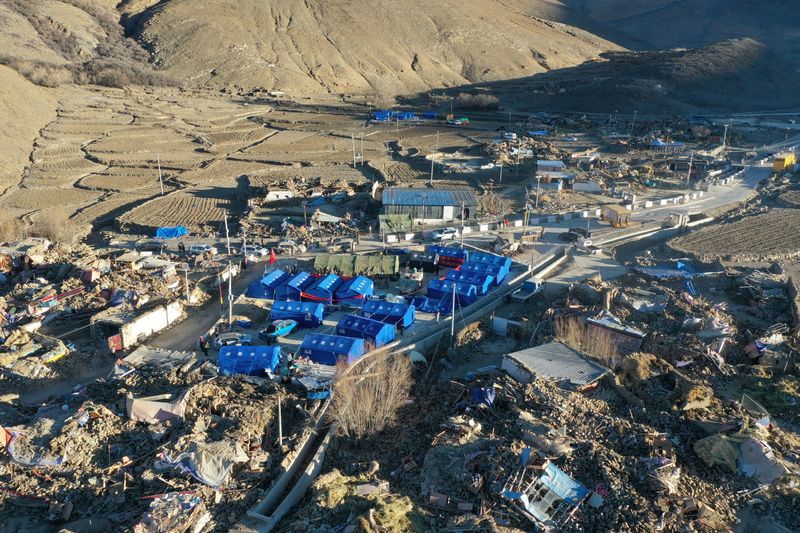By Joe Cash and Ryan Woo
BEIJING (Reuters) - Authorities moved more than 47,000 people to shelters in earthquake-hit Tibet, Chinese officials said on Thursday, while rescuers widen a massive combing effort for survivors near the foothills of the Himalayas, despite slim survival odds.
It is not yet clear how many are still missing after Tuesday's quake of magnitude 6.8 killed 126 and injured 188, but more than 48 hours later, experts say those trapped under rubble are likely to have died of hypothermia.
Officials pledged to keep up their search for survivors, despite the dwindling odds in temperatures that dropped as low as minus 18 degrees Celsius (zero degrees Fahrenheit) by night.
"The first round of full-scale search and rescue work has concluded," one of them, Hao Tao, told a press conference on Thursday. " Next (LON:NXT), we will carry out large-scale search and rescue in depth and detail."
Officials were still assessing the scope of the disaster, which damaged four reservoirs, as well as the scale of losses, Hao added, but did not elaborate.
China sent 11,000 rescuers to the quake zone within hours of the first tremors, which were followed by more than 1,200 aftershocks. A vice premier, Zhang Guoping, led the effort, going to the hardest-hit areas.
The epicentre of the quake, one of the region's strongest in years, was in the rural county of Tingri, with a population of about 60,000, located about 80 km (50 miles) north of Mount Everest, the world's tallest peak.
The quake, which shook buildings as far away as Nepal and India, reduced to rubble more than 3,600 homes in Tingri and damaged 27,000 more at an average elevation of more than 4,000 metres (13,000 feet), that presents a challenge for rescuers.
While authorities have not updated Tuesday's tally of dead and injured in state media, the official Xinhua news agency said rescuers focused on 27 villages home to 7,000 people spread 20 km (12 miles) around Tingri.
The quake followed a northward compression of the Indian tectonic plate, state media said on Thursday, citing the China Earthquake Networks Centre.
The plate, which collided with the Eurasian tectonic plate about 60 million years ago, continues to move 5 cm (1.97 inches) northeast each year.
Tuesday's earthquake was so strong it caused part of the terrain around the epicentre to slip as much as 1.6 m (5 ft) over a distance of 80 km (50 miles), an analysis by the United States Geological Survey showed.
RECONSTRUCTION
About 47,500 people affected by the earthquake have been resettled at 187 sites in towns around the epicentre, as prefabricated homes go up to replace their tents. About 1,000 of the quake-proof, heated homes can be set up in 10 minutes.
There must be no slacking in the quake relief work, now at a critical stage, the Politburo Standing Committee, composed of China's highest-ranking officials, said at a meeting on Thursday, according to Xinhua.
It also emphasised ensuring social stability and improved housing and infrastructure to better tackle such disasters, it added.
The Tibetan Buddhist leader, the Dalai Lama, who is branded a "separatist" by Beijing, said he was deeply saddened by the quake and would pray for the victims. He was speaking in India, where he lives in exile after a failed uprising in 1959.
"Under the strong leadership of the CPC Central Committee, people in disaster areas will certainly be able to overcome the catastrophe and rebuild their homes," a Chinese foreign ministry spokesperson said on Wednesday.
"We are well aware of the Dalai Lama's divisive nature and political designs, and we remain on high alert."
The Panchen Lama, Gyaltsen Norbu, who is second in spiritual authority to the Dalai Lama, led about 900 monks in chanting prayers on Wednesday at the Tashilhunpo Monastery in Shigatse, Xinhua said.
Norbu, identified by Beijing in 1995 as the 11th Panchen Lama but not recognised by the Dalai Lama, has also made a donation to quake relief efforts.

The region's last comparable earthquake, of magnitude 6.9, which hit eastern Mainling in November 2017, was the strongest in southern Tibet since 1950.
It unleashed more than 300 aftershocks, affecting more than 12,000 people, injuring three and damaging nearly 3,000 homes.